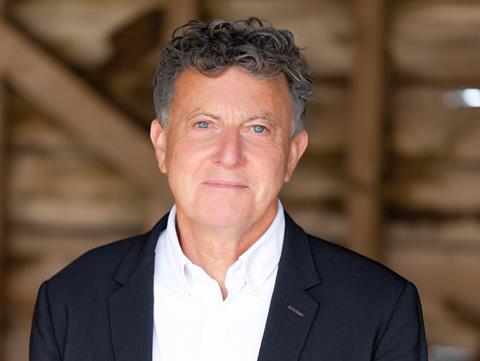In an in-depth interview, the WW&P co-founder and RIBA’s next president responds to criticism over “tone deaf” social post and tries to look forward
In 2003, Chris Williamson entered a competition run by housing developer Urban Splash for a site in Salford on the River Irwell. More than a hundred other entrants were also vying for the job, so the co-founder of WW&P, then known as Weston Williamson, knew it would mean putting in the hours. His team “spent many days, evenings and weekends” on its submission, including making architectural models and a film imagining what the development would be like for residents.
The practice was shortlisted for the interview, and Williamson drove up to Manchester the evening before, hands “armed with our models and drawings, so as to leave nothing to chance”. The interview went well and the practice was told a few days later that it had won the job.

For the next four years it worked with Urban Splash to prepare the planning application, which was eventually approved in 2007. Then, the following year, the financial crisis hit and the project was cancelled.
Williamson’s experience on the River Irwell scheme illustrates how frustrating the work of an architect can be. Huge amounts of time and resources invested by practices into winning work through the competition system very often come to nothing. And when they do win, there is no guarantee that the project will be built.
“Luckily, we have won enough competitions to not be continually depressed,” Williamson reflected earlier this year in a blog post recalling the project. But as a recent online row has made clear, not everyone in the profession is on the same page.
Fierce debate
Last month Williamson, who has been elected the next RIBA president, found himself in hot water after publishing a blog post defending architectural competitions as long as they are “well run”. In a 600-word post on LinkedIn, he recognised the unpopularity of competitions for many architects but confessed that he had “always enjoyed them”, despite admitting that many of his partners at WW&P disagreed with him.
“I find that competitions are stimulating, exciting and keep up the momentum of thinking and exploring,” he wrote, adding that they had helped him learn new skills that he otherwise would not have.
The original post, described by one architect as “tone deaf”, received a largely negative response from social media users in the comments section and provoked a wider debate about how competitions can be better run.
It comes amid heightened criticism of the competition process, which is seen by many in the profession to be exploitative and time-consuming at a time when firms are under increasing fee pressure.
Considerable unease was also expressed as a result of the post because of Williamson’s future role as RIBA president, which he will take up in September 2025.
“This is a very bizarre message for the RIBA president elect to be sending, and unfortunately, demonstrates how out of touch the institute is with its members,” wrote Corstorphine & Wright associate Josh Sykes in reply to the LinkedIn post.
Minimising unpaid work
Speaking to Building Design a week after the online row, Williamson denies that the RIBA is out of touch, insisting: “Everybody that I speak to at the RIBA is fully aware of what needs to be done and is trying to do something about it.”
Everybody that I speak to at the RIBA is fully aware of what needs to be done and is trying to do something about it
“The one thing that people can be reassured about is that they are trying to do their best, but I think it’s just agreeing how to do it.” He said he had his own views on how the process could be improved and was currently drafting his two-year vision for the RIBA.
One of his manifesto pledges during last summer’s RIBA presidential election was minimising unpaid work, including the late nights and weekend shifts often required to get competition entries in on time.
Williamson says RIBA can help young architects with business and negotiation skills needed to talk to clients and explain the principles behind a design idea without doing unnecessary amounts of work.
Clients, Williamson argues, “always choose people that are enthusiastic” about their project. “Being enthusiastic doesn’t actually mean doing a massive amount of work. It means being enthusiastic about telling people what you might be able to do for them”.
He believes competitions, while they can be onerous for architects, should “have a role” in choosing architects for a project and can allow young architects to compete on a “level playing field” with more established peers.
And he argues some amount of unpaid work is a reality “if you’re ambitious and you’re a young architect”. He brings up one of the replies to his blog post, in which one architect said she would “rather spend my precious free time on weekends with my family, than give more time to an underpaid, under-resourced profession.”
“That’s a lifestyle choice,” Williamson says. “That’s fine. I have no problem with that. That’s a great thing to do. Personally, I find [competitions] quite stimulating.”
Other comments beneath the post were more direct. Bell Phillips co-founder Hari Phillips replied to Williamson: “Mind. Blown. Is this a parody account?” Mo Enayet, architect and architectural manager at Mace, said: “What in the name of Part 1’s blood, sweat and tears is this!!!???”
I’m actually trying to take them on board and say, I agree, that competitions should be better run
Williamson also came under fire for allegedly “ignoring” messages received from architects since he won the RIBA presidential election raising concerns about the competition process.
Jeremy Till, former head of Central Saint Martins and now a professor emeritus for the University of the Arts London, wrote: “What a depressing post. As president elect you should be sensitive to that mailbag of concerns rather than simply ignoring them with stories of self-promotion.”
John McAslan & Partners director Andrew Shields asked Williamson added: “Got nothing to say, Chris? You seem as responsive to these comments as you are to those you ignore trying to bring your attention to their difficulties with this process.”
Williamson strongly denies the accusation. “I’m certainly not ignoring them,” he insists. “I’m actually trying to take them on board and say, I agree, that competitions should be better run, and that you should be able to enter competitions on the basis of your ideas, rather than how much time you’ve got.”
Williamson admits to being “in some ways” surprised by the reaction to the blog post because he believed it had been “quite a measured article”. He suggests that a lot of the post’s critics were “people taking entrenched views about things rather than reading what I wrote”.
Was the reaction partly a symptom of the pressure that practices are under because of reduced fees? “I think they are separate issues,” Williamson argues. “I think there’s a series of things we can do to ratchet up our fees, but I don’t think banning competitions is one of them.”
Moving forward
He says he understands concerns around competitions. “I’m a very open minded person, and I know everybody has different views, and I can see why people don’t like some architectural competitions, and that’s why I wrote the piece.”
But he concedes that he “probably [does] need to be a bit more measured in what I say”, reflecting criticism from one architect that he had been speaking from a “place of privilege” as a co-founder of WW & P, which employs 250 architects and is owned by French engineering giant Egis.
“It’s difficult, when you’ve run a practice for 40 years, you know, generally, if people ask for your opinion, you give it,” Williamson said.
“But I don’t want to be one of these people that say ‘no comment’. I just don’t think that’s helpful. I think people like a bit of honesty, but also, if you’re honest, you’re always going to get people that don’t agree with you.”
Many in the profession who sympathise with Williamson’s critics will now be watching closely to see how much the future RIBA president listens to those he disagrees with when he takes up his post at the institute.
>> Also read: Chris Williamson: ‘I think we can do a lot for young architects – they need all the help they can get’
















1 Readers' comment